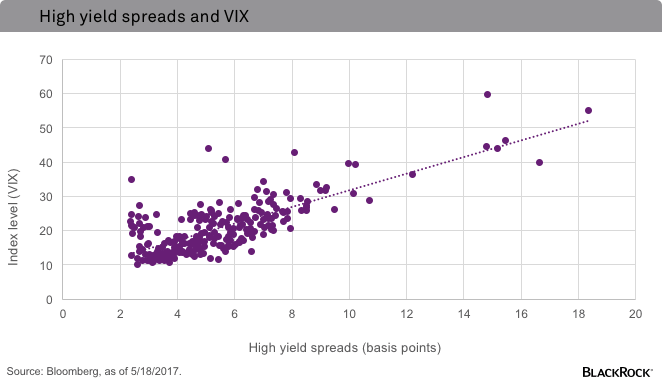With political uncertainty on the rise in D.C., will market volatility spike? Russ discusses why the economy and credit markets matter more.
by Russ Koesterich, Portfolio Manager, Global Allocation Team, Blackrock
Following a market friendly outcome in the French election and less market friendly political rumblings at home, the locus of political anxiety has shifted from Europe to the United States.
However, with the exception of a sharp but brief spike in volatility on May 17, investors are looking past the turmoil in Washington. Is this smart? Ultimately the answer has more to do with financial market conditions rather than machinations in Washington.
In comparing political volatility with the market variety, it is useful to have a measure of the former. One increasingly popular measure is the Economic Policy Uncertainty Index, a joint collaboration by professors at Northwestern, Stanford and the University of Chicago. High readings coincide with periods when investors are focused on a potential negative policy outcome. Examples in recent years include the dispute over the U.S. debt ceiling and European political turmoil.
However, equating policy uncertainty with market volatility is not as simple as it seems. Consider:
The relationship exists but it is not particularly strong.
During the past 20 years, the global measure of economic policy uncertainty explained less than 5% of the level of the VIX, the standard measure of equity market volatility. Looking just at the U.S. was more relevant; since 1997, the U.S Policy Uncertainty Index explained a bit more than 17% of the variation in the VIX. Still, these levels are well below various market indicators.
Political uncertainty and volatility move together.
The bigger problem is that policy uncertainty co-moves rather than leads. In other words, when policy uncertainty is high, volatility is also high, but the market tends to react in a very efficient and timely matter.
It is not that policy does not matter. It is simply that policy today does not tell me much about volatility tomorrow, unless you’re particularly good at predicting political outcomes.
Instead of focusing exclusively on Washington, investors would be better off tracking two measures closer to the market: leading economic indicators and credit spreads (see the chart below).
Since 1997, a two-factor model incorporating the Chicago Fed National Activity Index (CFNAI) and high yield spreads (the difference between the yield of a high yield bond and that of the 10-year U.S. Treasury) explained nearly 60% of the variation in the VIX. Adding the Uncertainty Index to the model does not improve its efficacy.
Right now both leading indicators and credit markets are suggesting what most investors intuitively realize: The VIX should be low, although arguably not as low as 10. The two-factor model suggests fair value for the VIX somewhere in the mid-teens, roughly where it peaked last week. To the extent credit markets take the events in Washington in stride—even during the worst selling last week high yield spreads remained comfortably below 400 basis points (4%)—equity investors can breathe a little easier, at least until they can’t.
Russ Koesterich, CFA, is Portfolio Manager forBlackRock’s Global Allocation team and is a regular contributor toThe Blog.
Copyright © Blackrock
















